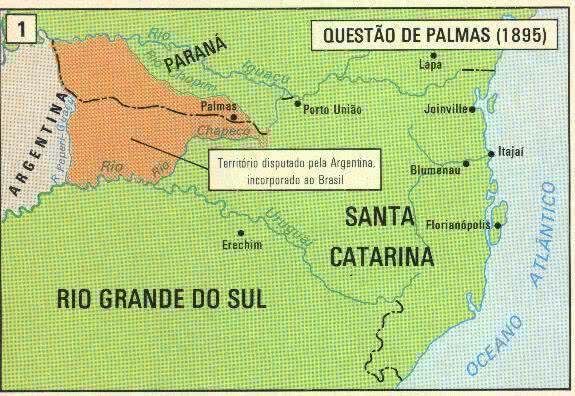At hereditary captaincies they were the first real colonization measure taken by the Portuguese in relation to Brazil. With the captaincies, a system of administrative division was implemented by order of the Portuguese king D. John III, in 1534. Portuguese America was divided into 15tracksinEarth, and the administration of these lands was handed over to the grantees. The captaincies existed in Brazil for centuries, but from 1548 onwards, a new way of administering Brazil was created.
Also access:General language: the main language spoken in Portuguese America
Historical context
In April 22, 1500, the expedition led by Pedro Alvares Cabral he sighted Monte Pascoal, officially marking the arrival of the Portuguese on the American continent. Despite the arrival on the new continent being something remarkable, the Portuguese, at that time, had as economic priority the spice trade in India.

Thus, the Portuguese stayed a few days in Brazil and then left for Asia in order to fill the ships with the valuable goods obtained there. Therefore, within this context, the economic possibilities of Portuguese America were on the sidelines, because the spice trade was much more attractive than the possibility of colonial expansion.
Thus, the first thirty years of the history of Portuguese America were summarized in installation of factories on the Brazilian coast and in the exploration of the work of the indigenous people for the felling of pau-brasil, a valuable tree for the red resin that its wood had and which was useful in dyeing fabrics.
The 1530s, in turn, brought the need to the Portuguese to create mechanisms to guarantee their ownership of their land parcel in America. First, the spice trade was decaying. In addition, the French posed a threat to the Portuguese, as they invaded “Portuguese lands” (according to the Treaty of Tordesillas) and negotiated with the indigenous people.
Do not stop now... There's more after the advertising ;)
With that, the Portuguese king D. João III realized that it was necessary to increase efforts to guarantee the Portugal's interests in America. The solution found was as follows: Portugal would divide the territories of Portuguese America and hand them over to people interested in investing in the development of that region. All of the colony's investment work was passed on to third parties.
The Crown divided its territory in America into 15 plots of land corresponding to 14 captaincies and delivered them to the so-called captainsgrantees. This system was officially implemented from 1534 onwards.
What were the functions of the grantees?
The grantees were merchants and people from the gentry of Portugal who had a good relationship with the Portuguese Crown. The development of the captaincy was the exclusive function of the grantee, who received the right to explore the land through the Donation Letter. The grantee's duties in relation to the Crown were assigned through the Charter.
The land that was given to the grantees did not belong to them, but to the king of Portugal. However, the Letter of Donation gave them the right to settle in the colony to administer their captaincy in the best way possible. In the captaincy, the grantee was the greatest authority in existence, and the offenses and faults committed by them must be answered to the king.
As mentioned, the strategy of the Portuguese Crown was to have the colonization of Portuguese America carried out through private investmentsThus, all the investments necessary for the economic development of the captaincy were part of the function of the grantee. This included the development of infrastructure to attract those interested in settling in the captaincy. Grantees had the right to levy taxes in their captaincy and to distribute land (sesmarias) as they were interested.
When it came to infrastructure development, it was essential that grantees develop a structure that would provide a minimum of security for their captaincy. This occurred through fortifications, who expelled foreign invaders (mainly the French) and who guaranteed them protection from attacks by indigenous peoples hostile to the Portuguese.
Also access:The invasions carried out by the French in colonial Brazil
Hereditary captaincies and land grants
The grantee captains had as one of their attributions the distribution of land - called land grants – for those interested in settling in Portuguese America. Sesmarias were a model of land distribution that was created in Portugal, in the 14th century, and aimed to increase the production of food sent to Portugal, which was affected by the outbreaks of black Plague.
Here, land grants were given to people who were interested in settling in Brazil. Whoever received the sesmaria had the obligation to make it productive within a certain period of time. Land distribution was a mechanism used by the Portuguese to attract people.
there were some restrictions to receive an allotment. The person receiving it must, necessarily, be a Christian, must make the land productive within five years and must pay all taxes owed to the Crown.
Hereditary captaincies that prospered
The captaincies were not a very successful undertaking. Of the 14 captaincies installed, only the captaincies of Saint Vincent it's from Pernambuco have had a relative degree of success. The prosperity of these two captaincies, according to historian Boris Fausto, is related to the development of sugar production combined with a less hostile policy towards the indigenous|1|.
The development of these captaincies, however, did not occur without friction with the Crown, as exemplified by the historian Evaldo Cabral de Mello. The donor of the captaincy of Pernambuco, Duarte Coelho, for example, had reservations about the pressures carried out by the Crown to invest in the search for precious metals and the overthrow of the brazilwood|2|.
This grantee wanted to implement in his captaincy the model he had witnessed in the Wood Island: sugar production in small and medium-sized mills with room for diversification in land use. Despite these frictions, Pernambuco prospered in the way Duarte Coelho wanted.
Failure of hereditary captaincies
Hereditary captaincies as a form of administration and colonization of Portuguese America failed. Their existence in Brazil extended until the 18th century, but this system, as the only one existing in development the colonization of Brazil, was quickly replaced by another, which created a structure that centralized power in the Cologne.
This resulted in the creation of the General Government, a system in which a centralized government in the colony was instituted and administered by a maximum authority, called general governor. For this, the Crown dissolved the captaincy of Baía de Todos os Santos and guided the first governor-general to create the first capital of Brazil there. Thus, Tome de Sousa founded Savior, in 1549.
The failure of captaincies is related to multiple factors. The first one is the isolation, as there was little contact between the captaincies, and communication with the Crown was time-consuming. THE lack of investmentsandresources to develop the captaincies and the inexperienceadministrative of grantees were other relevant factors for the failure of this system.
There were cases where the grantee did not even bother to go to his captaincy, as happened with Antônio Cardoso de Barros, grantee of the Captaincy of Ceará. Another important factor in the failure of the captaincies was the indigenous attacks, which, when they happened, resulted in the death of large numbers of people.
Hereditary captaincies and their grantees
As mentioned, Portugal created 14 captaincies arranged in fifteen plots of land and handed over to 12 donor captains. Below, we list the names of all captaincies and their respective grantees:
Captaincy |
Grantee |
Maranhão (lot 1) |
Aires da Cunha and João de Barros |
Maranhão (lot 2) |
Fernando Álvares de Andrade |
Ceará |
Antônio Cardoso de Barros |
big River |
Aires da Cunha and João de Barros |
Itamaracá |
Pero Lopes de Sousa |
Pernambuco |
Duarte Coelho |
All Saints Bay |
Francisco Pereira Coutinho |
islanders |
Jorge de Figueiredo Correia |
safe harbor |
Pedro do Campo Tourinho |
Holy Spirit |
Vasco Fernandes Coutinho |
Saint Thomas |
Pero de Góis da Silveira |
Saint Vincent |
Martim Afonso de Sousa |
Santo Amaro |
Pero Lopes de Sousa |
Santana |
Pero Lopes de Sousa |
Also access:See the history of the Tupinambá Indians who were taken to France in the 16th century
Hereditary captaincies map
Another very important issue regarding the study of hereditary captaincies is how they were portrayed on maps. Most of these maps were produced in the 16th century. One of the most classic maps that have served as a reference for historians over the years was the map produced by the Portuguese cartographer LuísTeixeira, in 1586. See the map by Luís Teixeira below:
![The map of Brazil produced by Luís Teixeira, in 1586.[1]](/f/d74e5bc571adab2611f514e38147916e.jpg)
This view of the maps on the hereditary captaincies has been the subject of reassessment by a recent study carried out by university professor Jorge Pimentel Cintra, who concluded that the geographical distribution of captaincies on the map of Portuguese America is quite different from that which was agreed to believe. Below is the new map of the captaincies according to the new studies carried out:

Grades
|1| FAUSTO, Boris. History of Brazil. São Paulo: Edusp, 2013, p. 42.
|2| MELLO, Evaldo Cabral de. A New Lusitania. In.: MOTA, Carlos Guilherme. Incomplete trip: the Brazilian experience. São Paulo: Editora Senac, 1999, p. 75.
Image credits:
[1] Image credit: commons
[2] Image credit: Jorge Pimentel Cintra (2013)
By Daniel Neves
History teacher



